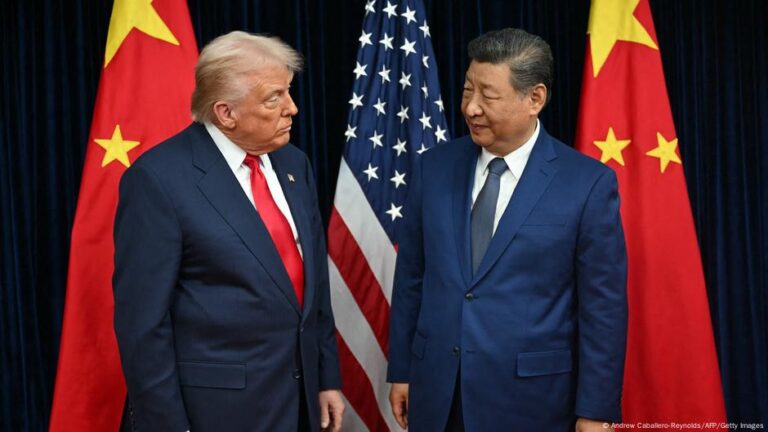Thursday’s high-stakes encounter between US President Donald Trump and his Chinese counterpart Xi Jinpingwas meant to help resolve months of global tariff tensions and smooth trade between the world’s two largest economies.
While Trump gave the “amazing” talks a 12 out of 10, Beijing was more cautious, calling on the United States to keep the lines of communication open.
For anyone hoping for a bigger thaw in US-China ties, the brevity of the meeting was a sobering reminder that mistrust between the world powers still runs deep. The closely-watched meeting in Busan, South Korea, lasted just 100 minutes, compared to the US president’s anticipated three to four hours.
Trump revealed few new specifics about the limited deal, which the White House announced earlier this week, to pause tariff hikes, defer rare earth export curbs and resume US soybean imports.
Xi, meanwhile, was cited by the Chinese state-run Xinhua news agency as saying the two leaders had reached a “basic consensus” on economic and trade ties. He urged both sides to focus on the long-term benefits of cooperation and not fall into “a vicious cycle of retaliation.”
Short meeting, shallow results
Deborah Elms, head of trade policy at the Hinchrich Foundation trade think tank in Hong Kong, spoke of “an interesting outcome” to the talks, noting the lack of a prepared announcement at the end and no joint news conference.
“I think there was insufficient clarity on both sides about what might be announced and concern over the potential for changes in commitments,” Elms told DW.
Market reaction to the talks was muted. An initial rally in Chinese stocks quickly faded as investors awaited concrete details on the fragile truce’s implementation. US stock futures were also lower on Thursday morning.
“Equities traded higher into the Trump-Xi meeting but were then underwhelmed by the lack of detail,” Anna Wu, cross-asset strategist at Van Eck Associates Corp, told the Bloomberg news agency. Wu added that the deal was being viewed as a “tactical truce” and warned that the outlook “could stay volatile.”
What did Trump say had been agreed?
Trump said he had agreed to US tariffs on China’s fentanyl-related trade by 10% from 20% in return for Beijing’s promise to do more to cut the trade in the deadly opioid, which has caused record overdose deaths across the US.
Talking to reporters on the US presidential airplane following the talks, Trump said China had agreed to a one-year deal to ensure the smooth supply of rare earths, crucial minerals needed to manufacture high-end technology. China controls 70% of the world’s supply. China’s Commerce Ministry confirmed this move.
Beijing has been accused of weaponizing its dominance on rare earths by sharply tightening export controls, requiring licenses for products containing even tiny amounts of Chinese-sourced minerals or produced using its refining technologies.
“The 10% reduction in tariffs comes without any details of how [China’s] rare-earth export licenses are going to be eased,” Alicia Garcia-Herrero, chief economist for Asia-Pacific at French investment bank Natixis, told DW. She noted how rare earths had given China “the upper hand” in trade negotiations.
Trump said the two leaders had also discussed the ongoing tussle over high-end semiconductors, needed to power military technology and advanced artificial intelligence (AI). He hinted that China would likely step up purchases of US chips, although not NVIDIA’s top-tier Blackwell line. Beijing has yet to confirm this.
After the US imposed export curbs to prevent China from accessing its most advanced chips, Beijing poured billions into ramping up its own chip sector, which has spiked domestic innovation.
Following the talks, Trump wrote on his Truth Social platform that China had agreed to soon begin buying US energy, hinting at a “large-scale transaction” to buy oil and gas from Alaska.
The US president also said China had now agreed to buy “tremendous” amounts of US soybeans and other agricultural products after a boycott sparked by the trade war.
Beijing was again more cautious, saying both sides had agreed to strengthen cooperation on energy and trade.
Arms race ignited?
In a sign of Trump’s desire to counter China’s chokehold on rare earths, which has given Beijing negotiators the edge, the US president announced an immediate resumption of US nuclear testing, the first in 33 years, with a focus on submarine capabilities.
Timed just hours before talks with Xi, Trump said on Truth Social that the move would put the US on an “equal basis” with rivals.
The announcement drew swift criticism from arms control experts, who warned it could unravel decades of nonproliferation norms.
Garcia-Herrero, who is also a senior fellow at the Brussels-based think tank Bruegel, said “Trump knows that’s where they [the US] have leverage, compared to economic issues,” adding that the announcement was “really scary.”
She warned that market reaction could be “very negative if this turns out to be a real escalation on the nuclear, rather than economic front.”
Little progress on core rivalries
Despite the detente, the talks yielded far less progress than anticipated. In addition to the missing substance of the agreements, key structural issues, such as intellectual property protections, artificial intelligence and strategic competition, were largely sidestepped.
Both the US and Chinese economies remain exposed to the lingering effects of the nearly yearlong trade war. Elevated tariffs, disrupted supply chains and investor uncertainty continue to weigh on growth.
China’s real estate crisis and sluggish domestic demand have eroded consumer confidence. The US, meanwhile, faces persistent inflationary pressures and weakening industrial output, raising fears of a broader slowdown.
While the temporary easing of tensions may offer short-term relief, analysts believe the risk of renewed escalation looms large without deeper reforms or sustained cooperation.
Edited by: Uwe Hessler


